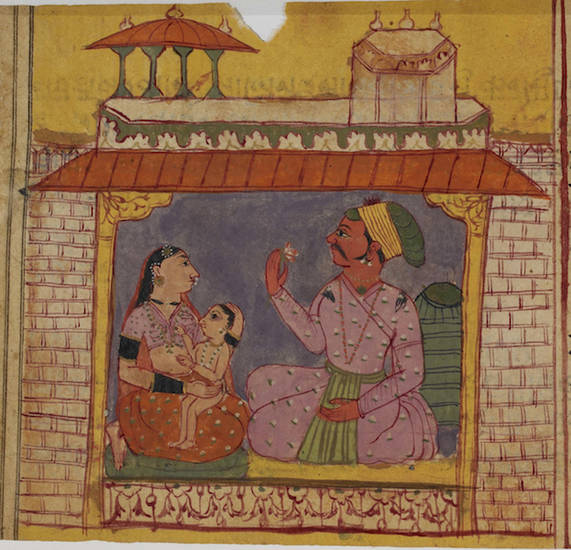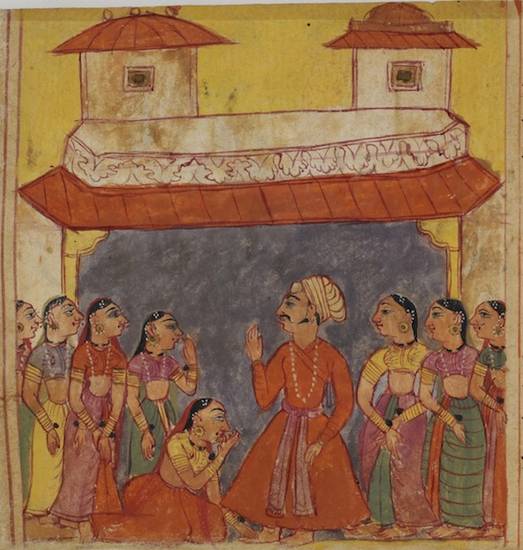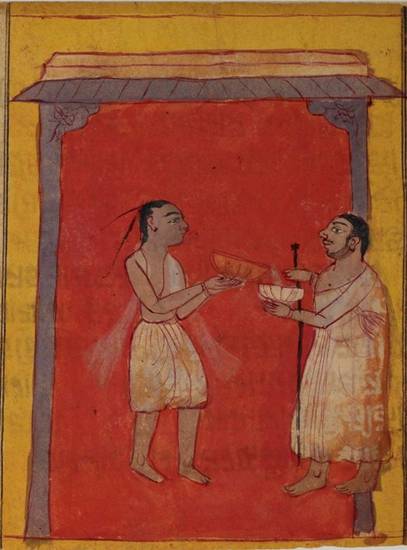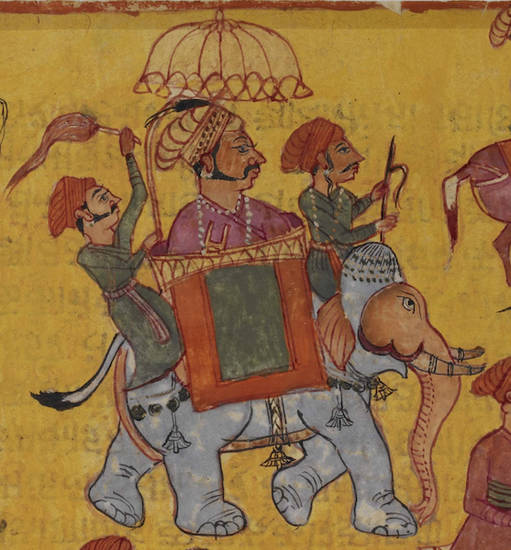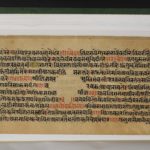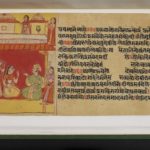Article: Story of Śālibhadra
One of the most important Jain tales, the Story of Śālibhadra has enjoyed wide circulation among Śvetāmbara Jains in Gujarat and Rajasthan. It has been passed down through the centuries in the main languages Śvetāmbaras have used, namely Prakrit, Sanskrit and Gujarati. It is a good representative of religious teaching in narrative form – dharma-kathā. Its significance comes from the restaging of the key concept of giving alms to monks – dāna – which is one of the fundamental duties and daily activities of Jain followers. Like almost all Jain stories, it illustrates the working of karma and rebirth and shows how the main protagonists ultimately become Jain monks before, in the end, attaining final liberation. The mendicants in this tale also illustrate the practice of fasting unto death, for which Jain monks have become famous.
Early versions of the tale tend to revolve around certain episodes that emphasise individual religious topics, such as offering alms or fasting to death. Fully developed versions of the story are very eventful and popular.
One of the highlights of JAINpedia, the manuscript digitised on the website is the Gujarati version composed by the Śvetāmbara poet Matisāra in the 17th century. In verse and based on musical modes, Matisāra’s account is well known and copies are reasonably common. This manuscript, executed in Jaisalmer, Rajasthan, has some noteworthy features. It is clearly dated and gives the name of the painter who has skilfully illustrated numerous episodes of the story, which can thus be easily followed in both the texts and images.
Rich visuals feature in many versions of the story, with several illustrated manuscripts surviving, all created in Śvetāmbara circles. The artistic tradition surrounding this tale is very varied in style, free of conventions seen in other Jain art and frequently demonstrating sectarian associations.
The history of Śālibhadra is a favourite of the Śvetāmbara Sthānaka-vāsins, who reject temples and the worship of images, neither of which are mentioned in the story. However, the JAINpedia manuscript can be identified as having been produced by Mūrti-pūjaka or image-worshipping Jains. In addition, its colophon underlines one of the main characteristics of painted manuscripts of this tale. This is that the story of Śālibhadra is often performed, with music, among Jains of the diaspora in particular.
Story outline
The tale of Śālibhadra tells of a very wealthy young man who abandons all his possessions and comforts to turn to monastic life, marked by hardships. Turning one’s back on a worldly fortune is highly meritorious among Jains, who have coined the phrase ‘rich like Shalibhadra’ to describe someone who is extremely affluent.
The main theme of the work is the giving of alms to mendicants, which is one of the duties of lay Jains and brings merit – puṇya. The laity’s donating to ascetics helps bind together the four parts of the Jain community and is thus an important act both spiritually and practically. In Jain treatises on lay conduct, such as the 14th-century Śrāddhavidhi by Ratnaśekhara-sūri, Śālibhadra is mentioned as the exemplary figure with regard to offering food to mendicants. In the tale’s two episodes featuring alms-giving, the emphasis is not so much on the thing given as on the spontaneity of the act of giving and the feeling of deep joy it produces.
Known in several versions, the story offers differences in details. Here is an outline of the main stages.
Initial alms-giving to a monk
Dhanyā, a poor widow, does her best to bring up her son, Sangama. The child works as a shepherd while his mother sells milk. On a festival day, he notices that rice made with sugar and milk – a treat – is being prepared at others’ houses and asks his mother if he can have some milk-rice too. She cannot provide any, but neighbouring women come to her rescue.
When the boy is about to eat, a Jain monk happens to come to the house, begging alms to break a month’s fast. Sangama sees this as an unexpected opportunity and offers the whole dish to him with joy and devotion.
When his mother comes back and sees the dish empty, she serves him more food. Sangama dies the same night.
Rebirth as Śālibhadra
Rājagr̥ha is the capital city of King Śreṇika, who rules with his son and minister Abhayakumāra. The rich merchant Gobhadra and his wife Bhadrā also live there. Sangama is reborn as their son, Śālibhadra. His name comes from the dream his mother has while pregnant, in which she saw a field of ripe rice – śāli.
In due course, this beautiful young boy is married to 32 wives. Gobhadra decides to turn to ascetic life, later on fasts to death and then is reborn as a god. As a god, he continuously helps his son by showering him with immense wealth.
One day, merchants come to the king’s palace, offering him exquisite shawls for a high price. He refuses so they go to Śālibhadra’s house, where his mother buys them and gives them to her daughters-in-law. When the king happens to hear this, he sends an envoy to Bhadrā’s house to buy the shawls, but learns that they are no longer available. He is amazed at what the wealth of Śālibhadra must be, greater than his own.
Highly intrigued, the king calls the boy to his palace, but the mother comes instead, saying that her son never leaves the house, and invites the king to visit them. He accepts and is received with great pomp.
Śālibhadra’s awakening

King Śreṇika clasps Śālibhadra
Image by British Library © CC0 1.0 (Creative Commons Public Domain)
Bhadrā informs her son that the king has arrived, according to the versions implying or stating that he is an important person who should be respected. This makes Śālibhadra reflect on what a real king would be and what real power is. This causes him to become aware of what being in the world requires and how it implies accepting subordination.
Yet he comes to pay his respects to King Śreṇika, as his mother wishes. However, when the king touches him, Śālibhadra, whose body is extremely tender, cannot bear his contact and, according to some versions, bursts into tears. The king returns to his palace, after having been sumptuously entertained by Bhadrā.
Śālibhadra’s decision to turn to ascetic life
After listening to the Jain monk Dharmaghoṣa preaching, the young boy is determined to become a monk. However, his mother strongly opposes his decision so Śālibhadra decides to wait. But he renounces his wives one after the other.
Dhanya and Subhadrā
Śālibhadra’s sister, Subhadrā, is sad at the thought that her brother intends to renounce worldly life stage by stage. She shows her sadness in front of her husband Dhanya.
Dhanya thinks that there is no reason to postpone anything good. Subhadrā and his seven other wives mock him as a teacher who does not put his teaching into practice. He takes them at their word and decides to turn to ascetic life. His wives try to prevent him, but are unable to do so. They also decide to become mendicants.
Dhanya and Śālibhadra as monks
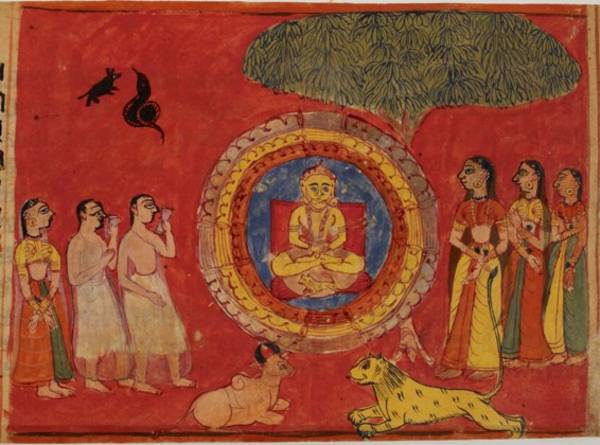
Mahāvīra and the universal gathering
Image by British Library © CC0 1.0 (Creative Commons Public Domain)
Mahāvīra happens to preach in Rājagr̥ha. While attending the sermon, Śālibhadra sees that his sister and brother-in-law have become ascetics and is strengthened in his decision. He takes monastic vows, leaving his mother and wives in sorrow.
Dhanya and Śālibhadra lead the life of perfect ascetics, in particular observing various fasts. One day Mahāvīra announces that they will break their month’s fast at the hands of Śālibhadra’s mother.
Second alms-giving to monks
The monks go to Bhadrā’s house, but nobody attends to their needs.
Outside the city, they meet a milk-woman, who is overcome with joy when she sees them. She offers them alms.
It so happens that this lady is Śālibhadra’s mother in his previous birth as Sangama.
Fasting unto death
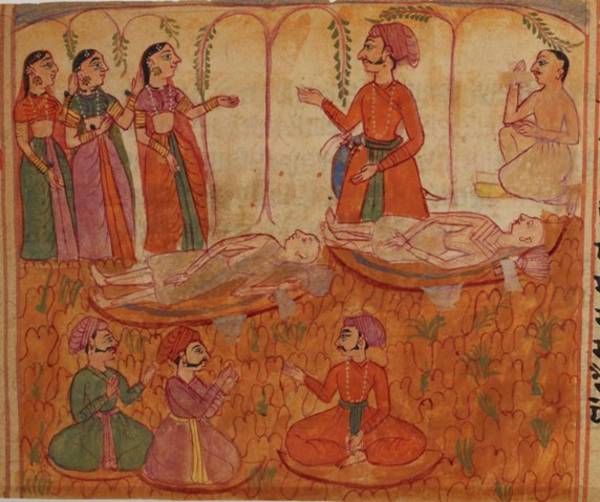
Dhanya and Śālibhadra fast unto death
Image by British Library © CC0 1.0 (Creative Commons Public Domain)
Encouraged by Mahāvīra, both Dhanya and Śālibhadra reflect upon their earlier lives, then undertake the ritual of fasting unto death.
When she learns about the condition of her son, Bhadrā is again grief-stricken.
The two ascetics are reborn as supreme gods in the heaven called Sarvārtha-siddhi, where they enjoy the highest bliss.
Development of the tale
The Story of Śālibhadra has been extremely popular for centuries among Śvetāmbaras and there are many variations of the tale. The story has changed focus and developed over time. Some versions revolve around one particular character, while separate tales elaborating the life of Dhanya have also arisen. Individual episodes in the outline above have often been treated as separate tales and may occur in collections of stories to illustrate certain Jain beliefs. With the passage of time, however, the whole story summarised above has become more common. Both famous monks, who were leading intellectual authorities in their time, and anonymous writers have reworked the tale over almost two thousand years. There are scores of versions, in prose and verse, taking a variety of literary forms.
The Story of Śālibhadra is often known as the Dhanya-Śālibhadra Story, because Dhanya is a key figure and the destinies of both characters are linked together in the later stages of the story. There are also accounts of Dhanya’s life before he marries Śālibhadra’s sister and thereby becomes his brother-in-law. One example is the Dhanya-vilāsa by Kalyāṇa kavi, composed in 1624 CE (Bender 1992: 7).
Versions stressing a single concept
Early versions of the stories are found in works that are peripheral to the canonical scriptures. These are not eventful or sentimental as they tend to become later and do not contain all the episodes outlined above. Instead they focus on a single key concept. This may be offering alms, fasting to death or renunciation of material wealth.
The Āvaśyaka commentaries include the paradigmatic episode of the poor boy who is about to eat a delicious dish but offers it to a Jain monk instead. Here the character is named Kr̥tapuṇya – the name Śālibhadra does not occur in this context. The incident is meant to illustrate the concept of alms-giving – dāna – and is reused in many stories, which may feature characters of different names.
In some cases the story is meant to illustrate the concept of fasting unto death, and is then restricted to the final part. This happens in the Maraṇa-samāhi. This text is one of the Prakīrṇakas, a category of texts specialising in this topic. In this work Dhanya and Śālibhadra are highly praised as two monks who perfectly observed this practice on Mount Vaibhāra.
In another didactic text, the Uvaesamālā, Śālibhadra is singled out because, even though he is immensely rich, he has no more desire for worldly wealth. He realises that being a lord or powerful person does not mean being a king in the material sense.
Story in different contexts
The story in its full form is found either as an independent tale or in collections.
When these story collections are thematically arranged, the Śālibhadra tale occurs in the sections devoted to giving alms to monks – dāna. This is because giving alms is the fundamental principle it is meant to demonstrate, as in the Mūlaśuddhi-prakaraṇa or Ākhyānaka-maṇi-kośa. This concept is so closely associated with this story that one of the versions mentioned below is also known under the title Wishing Tree of Alms-Giving – Dāna-kalpa-druma – which means the ‘best story about giving alms’.
Another context where the story may be included is the telling of Mahāvīra’s life. One instance is the 12th-century monk Hemacandra’s biography of Mahāvīra. It is inserted here because:
- Rājagṛha, one of the most important places in the geography of Mahāvīra’s life, is the city where the story takes place
- King Śreṇika, a contemporary of Mahāvīra, is a figure in the story
- of Mahāvīra’s presence in the later phase of the story, when Dhanya and Śālibhadra are presented as monks who wander with him.
Numerous versions
It would be irrelevant and almost impossible to give an exhaustive list of all versions of the story of Śālibhadra. The table includes a representative selection. More are mentioned in Shah 1983 (pages 22 to 37), coming to a total of 50. Of these, nine are in Sanskrit and 41 in Gujarati, with several of them undated.
|
Author |
Title |
Details |
Date and language |
Key concept |
Publication reference |
|---|---|---|---|---|---|
|
unknown |
Maraṇa-samāhi |
stanzas 444 to 447 |
fasting to death |
|
|
|
unknown |
Āvaśyaka-niryukti |
initial episodes in the story of Kr̥tapuṇya |
|
Balbir 1990: 26–28 |
|
|
Jinadāsa |
Āvaśyaka-cūrṇi |
initial episodes in the story of Kr̥tapuṇya |
|
giving alms to monks |
Balbir 1990: 26–28 |
|
Dharmadāsa |
Uvaesa-mālā |
verse 85 and commentaries |
|
giving up copious wealth |
|
|
Āvaśyaka-ṭīkā |
initial episodes in the story of Kr̥tapuṇya |
|
giving alms to monks |
Balbir 1990: 26–28 |
|
|
Jayasiṃha-sūri |
Dharmopadeśa-mālā-vivaraṇa |
story number 32 in the collection |
|
giving alms to monks |
|
|
Jineśvara-sūri |
Kathā-kośa-prakaraṇa |
|
|
|
|
|
Pradyumna-sūri |
Mūla-śuddhi-prakaraṇa |
story number 33 in the collection |
|
full story in the section on giving alms |
|
|
Malayagiri |
Āvaśyaka-vṛtti |
|
giving alms to monks |
Balbir 1990: 26–28 |
|
|
Nemicandra-sūri |
Ākhyānaka-maṇikośa |
story number 8 in the collection, and the commentary by Āmradeva-sūri |
|
full story in the section on giving alms with several dialogues |
|
|
Hemacandra |
Triṣaṣṭi-śalākā-puruṣa-carita |
within Mahāvīra’s biography, Book X, chapter 10 |
|
|
Johnson 1962: 254–262 |
|
Pūrṇabhadra of the Kharatara-gaccha assisted by Sarvadeva-sūri |
Dhanya-Śāli-caritra |
full independent story |
|
|
|
|
Dharmakumāra assisted by Pradyumna |
Śālibhadra Carita |
full independent story |
|
|
published in Yaśovijaya Granthamālā, Banaras, 1910; Bloomfield 1923 |
|
Padma |
Śālibhadra-kakka |
|
|
|
critical edition and German translation in Baumann 1975: 102–133 |
|
Rājatilaka |
Sālibhadra-rāsu |
|
|
|
Bhayani and Nahta 1975: 63–67 |
|
Sādhuhaṃsa |
Śālibhadra-rāsa |
|
|
|
|
|
Jinakīrti of the Tapā-gaccha |
Dhanya-Śāli-caritra or Dāna-kalpa-druma |
|
|
|
published by Devchand Lalchand Jain Pustak Fund, 1919 |
|
Dayāvardhana |
Dhanya-Śāli-caritra |
|
|
|
published in Bhavnagar, Gujarat, 1914 |
|
Jayānanda-sūri |
Dhanya-carita |
|
|
|
|
|
Matiśekhara |
Dhannā-rāsa |
|
|
|
|
|
Vinayasāgara-gaṇi |
Śālibhadra-caritra |
|
|
|
|
|
Dhannā-Śālibhadra copāi |
|
|
|
Shah 1983 |
|
|
Matisāra (Bender 1992) or, unlikely, Jinarāja-sūri (Shah 1983: 28) |
Śālibhadra-rāsa |
|
|
|
Bender 1992 |
|
Jñānasāgara-gaṇi |
Dhanyakumāra-caritra |
independent story |
|
|
|
Most of the famous Sanskrit independent versions are ample verse compositions in several chapters. The story is often expanded by didactic breaks, consisting of either praises of charity or alms-giving to monks and other virtues, or by descriptions.
The numerous Gujarati narrative poems – called kakka, rāsa, copaī or caupaī and sajjhāya – dedicated to this story range from short compositions to highly developed ones (see Shah 1983: 24–37). The earliest one seems to date back to the 14th century and there is a peak in production in the 17th century. These works use the metres and musical modes characteristic of poems written in this language. The kakka form follows a special device while telling the story, unfolding the full alphabet, so that one couplet starts with the syllable ka, the next one with kā, the next with ga, then gā and so on. (Baumann 1975: 102–133). Though they are in Gujarati, these poems normally use either the Sanskrit or Gujarati forms of the names of the two main protagonists, as follows:
- Śālibhadra or Sālibhadda
- Dhanya or Dhannā.
Matisāra’s version
The version of the Story of Śālibhadra by Matisāra is known by the title Dhanna-Śālibhadra-carita or Dhanna-Śālibhadra-copaī. Composed in Old Gujarati, Matisāra’s 17th-century verse version of the tale is well known among Śvetāmbara Jains. As is often the case with Gujarati narrative poems, information on the date of composition and author is found at the end of the work.
The story is divided into sections associated with musical modes – rāga – which is usual in Gujarati verse of this period. The tale includes all the episodes associated with the full story.
The personalities of the story’s characters come through strongly in this spirited version, which has been published several times in India. A scholarly treatment in English appeared in 1992.
On JAINpedia, the story of Śālibhadra is found in a manuscript held in the British Library in London and is one of the highlights of JAINpedia.
Form and story
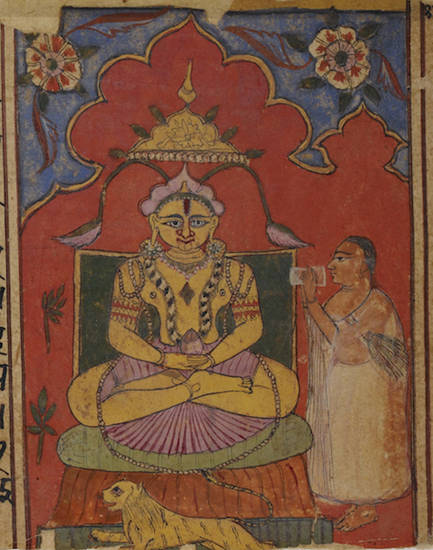
Auspicious painting of Mahāvīra
Image by British Library © CC0 1.0 (Creative Commons Public Domain)
The beginning and end of the text emphasise the concept of giving alms, while the story is divided into 29 sections called ḍhālas, each having approximately 35 to 40 stanzas. Each section is associated with a musical mode – rāga – in accordance with the rules of composition in Gujarati poetry. Each section ends with a stanza written in a metre different from the rest, a couplet known as dūhā.
Matisāra’s version of the Śālibhadra tale opens with an initial homage to Mahāvīra and other Jinas, which is a fairly standard way of beginning a Jain work. Then the power of giving alms is praised:
Śālibhadra obtained happiness and prosperity through alms-giving. By relating his story one drives sins far away. Pay close attention to the tale of Dhanya which is combined with it
Translation by Bender 1992, page 303
The text covers all the episodes described in the plot outline above, summarised in the table.
|
Ḍhāla section |
Story |
|---|---|
|
1 and 2 |
Initial alms-giving to a monk |
|
3 to 7 |
Rebirth as Śālibhadra |
|
8 |
Śālibhadra’s enlightenment: Never before, even in my dreams, have I recalled word[s] as harsh and poisonous as these uttered by my mother. I have wasted my rebirth wallowing in filth. Until today I never experienced the state of an inferior. I shall not bear on my head the command of anyone other than the Paramapuruṣa i.e. Mahāvīra |
|
9 to 17 |
Śālibhadra’s decision to turn to ascetic life: A man can obtain two merits by undertaking saṃyama [self-control]: he becomes an eternal king in the next existence, and, in this existence, he has no king over him. Thus two goals are gained by one path. |
|
17 to 21 |
Dhanya and Subhadrā |
|
22 to 25 |
Dhanya and Śālibhadra as monks |
|
26 |
Second alms-giving to monks |
|
27 to 29 |
Fasting unto death: They confessed and repented with mind, word and body whatever pains they had caused in connection with their practice of Saṃyama [= self-control], and he censured them at that time. They asked forgiveness of the 8,400,000 classes of existence and declared their friendship for all of them. With purified minds, they reverenced all the Jinas, the teachers in proper conduct [Dharmācāryas] and the Lord [Mahā]Vīra, especially. They undertook the Vrata to starve until death while standing like a tree [in a motionless meditation posture] and abandoned their lovely, desirable bodies to this. They resorted to the four wise refuges [= the Arhats, the Siddhas, the Sādhus and the dharma told by the Omniscient] and released themselves from selfishness. |
The story contains many monologues and dialogues and is told in a lively style. Although it includes a number of clichés, it is full of spontaneity in the way the various protagonists express their feelings or wishes. Outbursts of emotion are frequent in this version. Śālibhadra’s mother, Bhadrā, appears as a determined character who entirely runs her son’s life. Until he turns to monastic life, he seems a dominated and fragile child – although he is depicted as married to 32 wives. His brother-in-law is called by his Gujarati name, Dhannā, although Śālibhadra has the Sanskrit version of his name.
Matisāra’s version is quite popular and has been published in India several times. It has also been the subject of a critical edition, English translation and grammatical analysis by the American scholar Ernest Bender (1919–1996), which was published in 1992 in the American Oriental Society Series.
British Library manuscript
The story of Śālibhadra is represented on this website by the British Library manuscript Or. 13524, which has been fully digitised and is one of the highlights of JAINpedia. This manuscript is particularly interesting because of its 44 colourful paintings and the final colophons, which provide a lot of information. It was produced in the Jaisalmer fortress, in Rajasthan, in 1726 CE (1783 of the Vikrama era).
The colophon shows some rare characteristics, in that it is unusually detailed and stresses the visual aspect of the manuscript.
At a minimum, colophons provide the names of the monk who instigated the copying of the text and of the scribe and the recipient, but here the names of all those involved in the production of the manuscript are mentioned.
As is often the case in Gujarati works, the poem ends with verses giving information on the time of composition and on the author. The author gives the date, following the usual system of the Indian calendar, as the sixth day of the dark half of the month Āśo in the year 1678 of the Vikrama era, equivalent to mid-September to mid-October 1621 CE. The date this particular manuscript was copied is supplied in the manuscript colophon.
The name of the author is most frequently written as Matisāra, as it is in this manuscript held in the British Library. There is also a less common variant form, Matisāgara, found in some manuscripts of the work. Matisāra was a disciple of Jinasiṃha-sūri, and composed this work in accordance with the instructions of Jinarāja-sūri. This is Jinarāja II, who was head of the Kharatara-gaccha sect and flourished from 1618 to 1642.
In addition, the colophon puts particular emphasis on the visual aspect of the manuscript. First, it explicitly states that it is meant to be not only read, but also seen. Secondly, the painter’s name is given, which is unusual. Finally, this painter, Kanakakīrti, is clearly a monk, indicated by the term muni attached to his name.
Artistic tradition
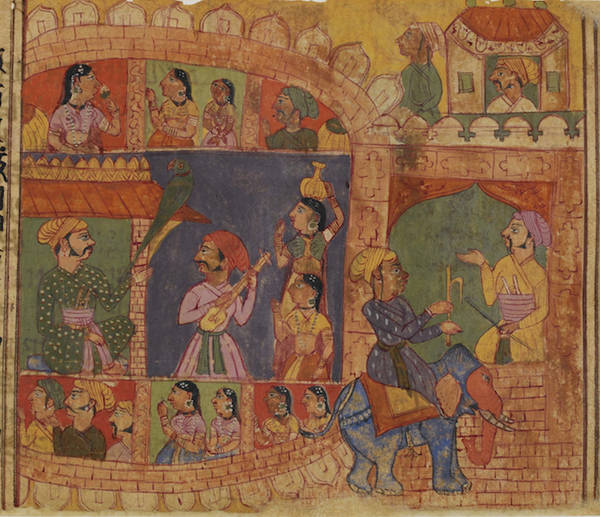
Life in Rājagr̥ha
Image by British Library © CC0 1.0 (Creative Commons Public Domain)
The story of Śālibhadra is one of the most important sources for Jain illustrated manuscripts created by the Śvetāmbaras. Practically all versions of the tale can give birth to visuals, but it seems that Matisāra’s version is among the most commonly illustrated. There are plenty of examples of manuscripts of the Story of Śālibhadra, most of which date back to the 17th century onwards and were produced in Gujarat or in Rajasthan.
The illustration styles in the manuscripts are extremely varied but are generally notable for their liveliness and freshness. Unlike much Jain art, paintings in the Story of Śālibhadra are not tied to standard scenes and artistic conventions.
It is popular among all Śvetāmbara Jains, but the Sthānaka-vāsins seem to greatly favour it, perhaps because the lack of temples and worship of images in the text supports their views on these matters. Indeed, some of the surviving manuscripts feature illustrations of Sthānaka-vāsin mendicants.
The paintings in the JAINpedia manuscript, however, point to the Mūrti-pūjaka Śvetāmbaras. This British Library manuscript has so many illustrations that they form an almost continuous pictorial version of the story, serving as much more than simple accompaniment to the writing.
Illustrated manuscripts
It is virtually impossible to list all the painted manuscripts of versions of the Śālibhadra story, as they are available in such large numbers. In some remarkable cases, the painter’s name is given. This table gives a selection, as noted in secondary literature.
|
Version of the story by author |
Date |
Details |
Collection or location |
Publication reference |
|---|---|---|---|---|
|
Matisāra |
1624 (1681 VS) |
|
|
|
|
Matisāra |
around 1700–1750 CE |
total number not indicated |
|
|
|
Dharmadāsa, Upadeśamālā with Gujarati commentary |
1708 (1765 VS) |
single manuscript illustration on folio 47 verso, of the milk-woman offering alms to the monks Dhanya and Śālibhadra |
|
|
|
Matisāra |
1726 (1783 VS) |
|
|
|
|
Matisāra |
1776 (1833 VS) |
67 illustrations |
|
Bender 1992: 23 |
|
Matisāra |
1793 (1850 VS) |
|
|
|
|
Matisāra |
1751 (1808 VS) |
58 illustrations |
|
Bender 1992: 21 |
|
Matisāra |
1761 (1818 VS) |
46 illustrations |
|
Bender 1992: 25 |
|
Matisāra |
1769 (1826 VS) |
51 illustrations |
|
|
|
Matisāra |
1776 (1833 VS) |
|
|
Van Alphen 2000: 104–111, colour illustrations and description |
|
Matisāra |
1782 CE (1839 VS) |
46 illustrations |
|
|
|
Matisāra |
1828 (1885 VS) |
47 illustrations |
|
Bender 1992: 30 |
|
Matisāra |
no date |
48 illustrations |
|
Bender 1992: 23 |
|
Matisāra |
no date |
|
|
Bender 1992: 23–24 |
|
Matisāra |
no date |
68 illustrations |
|
Bender 1992: 24 |
|
Matisāra |
no date |
|
|
Bender 1992: 24 |
|
Matisāra |
no date |
|
|
Bender 1992: 25 |
|
Matisāra |
no date |
49 illustrations |
Bender 1992: 27, plate one and plate two |
|
|
Matisāra |
no date |
single illustration |
|
Bender 1992: 27 |
|
Matisāra |
no date |
|
|
Bender 1992: 28 |
|
Matisāra |
no date |
59 illustrations |
|
Bender 1992: 29 |
|
Matisāra |
no date |
|
|
|
Artistic style
The manuscript paintings of the Śālibhadra story are generally very attractive, as they are colourful and lively. Unlike the Kalpa-sūtra paintings, the illustrations of the Uttarādhyayana-sūtra or the art portraying the Jain universe, for instance, they are not formalised or standardised. They show a certain amount of freedom in the variety of scenes depicted and in the way they are executed, demonstrating many details of daily life. There is scope to show a wide range of individuals, from the courtly elite to ordinary people, and to represent both interior scenes and natural landscapes.
There is a wide range of styles found in Śālibhadra manuscripts, ranging from Mughal to Rajasthani.
Sectarian links

Dhanya and Śālibhadra accept alms
Image by British Library © CC0 1.0 (Creative Commons Public Domain)
The Story of Śālibhadra is recognised as one of the tales that has been adopted by the sect of the Sthānaka-vāsins, ‘as no reference to temple or image worship is found in it’ (Nahar 1976: 6). The Boston Museum manuscript (Coomaraswamy 1924 / 2003: folio 23 on Plate XXVII; folios 33 to 35 on Plate XXIX) distinctly shows this sectarian affiliation, as the Jain monks in the story are depicted wearing white mouth-cloths. This mouth-cloth is typical of Sthānaka-vāsin monastic equipment. Mouth-cloths also appear in one manuscript in the Prince of Wales Museum, where they are painted in silver (Bender 1983: 278).
Even so, the British Library manuscript clearly has a Śvetāmbara Mūrti-pūjaka affiliation, with Dhanya and Śālibhadra shown carrying the monastic staff. Sthānaka-vāsin mendicants do not have this item of monastic equipment.
Visual storytelling
As shown in the table listing major illustrated manuscripts of the Story of Śālibhadra, the number of artworks in individual manuscripts is often high. This has the effect of the sequence of images forming a continuous visual narrative that parallels the story in the text. The captions, often found at the side of the pictures, emphasise this effect.
This is the case in the British Library manuscript on JAINpedia, which is detailed here.
|
Manuscript folio |
Illustration details |
|---|---|
|
The opening invocation to the 24th Jina Mahāvīra is translated into a painting showing him in the lotus position of meditation – padmāsana. His emblem, the lion, is sitting in front of him, while a monk pays him homage. |
|
|
Ladies in a pavilion, a musician and a man on an elephant are visual depictions of the exuberant atmosphere of Rājagr̥ha. |
|
|
The poor widow Dhannā takes her son to Rājagr̥ha, a city of hope for them. |
|
|
The boy Sangama looks after a herd of cows to earn a few coins. When a festival day comes and the little boy sees others enjoying milk-rice, he asks his mother for some. She is unable to satisfy his wish so she is heart-broken. |
|
|
Four ladies come to Dhannā, asking why she is unhappy. They bring ingredients for milk-rice. |
|
|
The boy pours the milk-rice into the begging bowl of a Jain monk who has arrived just as he was about to eat the delicious dish. The monk is shown holding the wooden staff typical of Śvetāmbara Mūrti-pūjak mendicants. |
|
|
The merchant Gobhadra and his wife Bhadrā are shown in their house. The lady is holding the child, Śālibhadra, on her lap. |
|
|
A well-dressed man sits in a large house, watching three ladies on his left. Three other women are busy fanning him. This is Śālibhadra and some of his wives. |
|
|
Bhadrā is bargaining with a man, while two others talk outside. They are the merchants who have come to her house to try and sell their expensive shawls, which are too costly for everyone else, even King Śreṇika. |
|
|
Having heard that Bhadrā has bought the shawls, the king sends an envoy to her house for a shawl. Bhadrā explains that she is not in a position to give him any shawls, since they have been given to her daughters-in-law, who have spoiled them. So the servant returns empty-handed. |
|
|
The king, intrigued and envious, sends his minister and son Abhayakumāra to Bhadrā’s house to fetch Śālibhadra. |
|
|
Bhadrā kneels in front of Śreṇika and touches his knees in a humble attitude. She asks him to visit Śālibhadra’s house, arguing that her son is too fragile to go out. |
|
|
Finally King Śreṇika, mounted on an elephant, departs for Śālibhadra’s house. He is accompanied by soldiers on horseback, camel and foot. |
|
|
Śreṇika and his entourage are shown round the house. The king is amazed by the beauty of the first floor – a life of ease in various small pavilions symbolises the luxurious atmosphere in Bhadrā’s house. |
|
|
When Śreṇika is shown the second floor of the house, he is even more astonished. |
|
|
And he is staggered by the sumptuous third floor. |
|
|
Meanwhile, Śālibhadra is in his private apartments, reclining on a couch and enjoying the company of his wives. His mother arrives to bring him to the king. |
|
|
Śālibhadra complies with his mother’s wish and comes to see the king, accompanied by his wives. |
|
|
The king shows his favour to the young man. Everyone present rejoices, except Śālibhadra himself. |
|
|
After meeting the king, Śālibhadra is thoroughly dejected, reflecting on what being a king really means. Even the company of his wives does not cheer him up. |
|
|
Bhadrā tries to soothe her son, who has decided that he should give up everything. |
|
|
A woodsman arrives at the house and reports that a Jain monk has come. |
|
|
Śālibhadra, happy of this opportunity, goes to pay his respects to the monk. The mendicant sits on a raised seat – āsana – in a park with trees where monkeys and peacocks are playing. |
|
|
Śālibhadra asks his mother to grant him permission to leave worldly life. |
|
|
Bhadrā tries to persuade her son not to do this and finally refuses his request, asking for a delay. |
|
|
Śālibhadra decides to leave his 32 wives one after the other. |
|
|
When the fourth wife realises that her turn will come the next day and that her husband will leave her at the end of the fourth part of the night, she climbs on the roof of the house. The caption says ‘the fourth wife marks the tigers’, referring to a phrase in the text. In many illustrations of this episode, the moon is pictured with four tigers, representing the four parts of the night. |
|
|
While Subhadrā is bathing her husband, Dhanya, she begins to weep, knowing her brother’s wish to give up the life of a householder. |
|
|
In vain Subhadrā tries to dissuade her husband from taking mendicant vows. |
|
|
She grips Dhanya’s sash to stop him from leaving. |
|
|
Subhadrā holds her husband’s feet to keep him at home. |
|
|
Dhanya tries to persuade his wives that he is right in wishing to renounce worldly life. |
|
|
He goes to Śālibhadra to tell him that his decision to give up worldly life is right and that he should continue with his plan. |
|
|
Dhanya is carried on a palanquin and wants to take the vows. |
|
|
Śālibhadra again asks his mother’s permission to become a monk. She finally agrees. |
|
|
Śālibhadra is carried on a palanquin, preceded by musicians. This scene indicates he is on his way to perform dīkṣā – the ceremony of initiation into mendicancy. Now monks, Dhanya and Śālibhadra live a wandering life. |
|
|
It so happens that Mahāvīra comes to preach in Rājagr̥ha. He is shown here in the samavasaraṇa – universal assembly – with his emblem, the lion, sitting at his feet. A lion and a bull, and a mongoose and a snake represent the pairs of natural enemies at peace on this occasion. Two monks and a group of śrāvikās – lay women – symbolise the audience. |
|
|
Mahāvīra had told Dhanya and Śālibhadra that they would break their month’s fast at the hands of Śālibhadra’s mother. But when they reach the gate of Śālibhadra’s former house, the doorkeeper does not recognise them and turns them away. This happens twice. |
|
|
A milk-woman is shown with a pot cooking on the fire. The pair meets her outside the city. She pours food into the bowl of one of the monks. |
|
|
Dhanya and Śālibhadra are emaciated monks as they have begun the ritual of fasting unto death. Three women, representing Śālibhadra’s mother and wives, pay the monks their respects. Other lay men and a monk surround the fasting men to honour them. |
|
|
After death, Dhanya and Śālibhadra are reborn in the Sarvārtha-siddhi heaven. It is depicted through gods shown in various compartments and two banners – dhvajas. |
|
|
Later on the pair are reborn. They become monks, fast to death and ultimately reach the final liberation from rebirth, symbolised by their sitting in meditation in the white crescent. |
Story in performance
Thus, the text, the musical modes and the paintings ‘are worked together into a dynamic multi-dimensional presentation […] inspiriting the progress of the narrative to its destined conclusion’ (Bender 1992: 18).
There is evidence in modern Gujarat that such stories, if not precisely the one in this manuscript, were and are performed in public, accompanied by music. The colophon of the British Library manuscript on JAINpedia suggests that the paintings were meant to be seen. They were probably displayed in temples or meeting-halls when the story was retold orally.
Today, the story of Śālibhadra is often staged in Gujarati or Hindi at community events, normally starring teenage amateur actors. Performing traditional tales is a way of transmitting the fundamental values of the faith among the diaspora. Such a play was one of the highlights of a celebration in 2009 of the Mahāvīr Jayantī festival in London.
Reading
- ‘Stories from the Āvaśyaka Commentaries’
Nalini Balbir - The Clever Adulteress and Other Stories: A Treasury of Jain Literature
edited by Phyllis Granoff
Mosaic Press; Oakville, Ontario, Canada; New York, USA; London, UK; 1990
- ‘The Micro-Genre of Dāna-Stories in Jaina Literature: Problems of Interrelation and Diffusion’
Nalini Balbir - Indologica Taurinensia
edited by Nalini Balbir and Colette Caillat
volume 11
International Association of Sanskrit Studies; 1983
- Drei Jaina-Gedichte in Alt-Gujarātī: Edition, Übersetzung, Grammatik und Glossar
George Baumann - Beiträge zur Südasienforschung Südasien-Institut Universität Heidelberg series; volume 20
F. Steiner; Wiesbaden, Hesse, Germany; 1975
- ‘A Lunar Illustration Occurring in Several Manuscripts of the Dhanya-Śālibhadra-Carita: An Old Gujarātī work of the XVIIth-XVIIIth Century A.D.’
Ernest Bender - Journal of the American Oriental Society
volume 88
1968
- The Śālibhadra-Dhanna Carita: The Tale of the Quest for Ultimate Release by Śālibhadra and Dhanna
Ernst Bender - American Oriental series; volume 73
American Oriental Society; New Haven, Connecticut USA; 1992
- ‘The Trials and Tribulations of a Text’
Ernest Bender - Journal of the American Oriental Society
volume 115: 2
1995
- Realms of Wonder: Jain, Hindu and Islamic Art of India
James Bennett - Art Gallery of South Australia, Adelaide; Adelaide, South Australia, Australia; October 2013
- ‘The Śālibhadra Carita: A Story of Conversion to Jaina Monkhood’
Maurice Bloomfield - Journal of the American Oriental Society
volume 43
1923
- ‘Catalogue of the Indian Collections in the Museum of Fine Arts, Boston: Part IV: Jaina Paintings and Manuscripts’
Ananda K. Coomaraswamy - Essays on Jaina Art
edited by Richard J. Cohen
Collected Works of Dr. Ananda Coomaraswamy series; volume 15
Indira Gandhi National Centre for the Arts and Manohar; New Delhi, India; 2003
- Guṇavinaya-kṛta Dhannā-Śālibhdra Copāi
Guṇavinaya - translated and edited by Ramaṇlāl C. Shah
R. R. Setha; Ahmedabad, Gujarat, India; 1983
- Steps to Liberation: 2500 Years of Jain Art and Religion
Jan van Alphen - Etnografisch Museum Antwerpen; Antwerp, Belgium; 2000
Links
- Śālibhadra play during Mahāvīr Jayantī
-
The Institute of Jainology reports on the celebrations of the 2009 Mahāvīr Jayantī festival in London. One of the highlights of the two-day celebration was the performance of Tyagveer Shalibhadra. Young people from the Shree Chandana Vidhyapeeth school performed this original play in Gujarati, which featured music and dancing, short dialogues and narrations.
http://www.jainology.org/235/jains-in-the-uk-join-hands-to-celebrate-mahavir-jayanti-2009/
- Play of Śālibhadra
-
Children perform the story of Śālibhadra in this YouTube video from 2011. The play was organised by the Jain Vishwa Bharati of North America, which is based in New Jersey, USA.
- Scene featuring Śālibhadra and his wives
-
This amateur video on YouTube shows a scene from the Hindi-language play of Śālibhadra, which was performed in August 2010 to commemorate the opening of the Jain Vishwa Bharati centre in Houston, Texas, USA.
- Children perform the Śālibhadra story
-
This YouTube video presents the tale of Śālibhadra performed by children from the Jain Center of Northern California. This play was part of the celebrations for the 2012 festival of Mahāvīr Jayantī, which took place on the 4th April.
- Performance of Śālibhadra
-
This YouTube video films children from the Jain Center of Greater Phoenix, in Texas, USA performing an English version of part of the story of Śālibhadra. Children often perform a shortened version of the tale, which emphasises the duty of giving alms to monks and nuns.
- Jain Literature and Theatre
-
A short essay entitled Jain Literature and Theatre by Atul K. Shah is available to read on the HereNow4U website. The author provides a background to the practice of the Jain faith and its expression in the performing of music, dance and drama,with a focus on Jains in the UK.
You will need to have Adobe Acrobat Reader on your computer to open PDF files.
- Animation of Śālibhadra
-
The first part of the story of Śālibhadra is presented as an animation on YouTube, uploaded in 2012. In this part of the tale, the young boy Sangama offers alms to a Jain monk, which is one of the key episodes in the story. The story of Śālibhadra is a Jain favourite that underlines the importance of lay Jains giving alms to mendicants.
- Possible illustration of Śālibhadra
-
The Metropolitan Museum of Art in New York presents an illustrated folio from a manuscript of the story of Śālibhadra. However, this attribution is uncertain.
http://metmuseum.org/Collections/search-the-collections/60004942
eLibrary Links
- Treasures of Jain Bhaṇḍāras
- Volume 69 in the L. D. Series focuses on illustrated palm-leaf and paper Jain manuscripts and features numerous reproductions in black and white or colour. The book includes an introduction to Jain manuscript art and a catalogue of important manuscripts preserved in libraries in Gujarat, India.
- New Documents of Jaina Painting
- Black-and-white and colour examples of Jain manuscript illustrations. The introduction offers an overview of the style of manuscript artwork, dubbed the Sirohi School, which developed in western India. The detailed catalogue provides information about the reproductions, many of which have been published for the first time.
- +
- aAbhavya
- aAbhinandana
- aAbhiṣeka
- aĀcāra
- aĀcārāṅga-sūtra
- aĀcārya
- aAchalbhrata
- aAḍhāī-dvīpa
- aAdharma
- aAdho-loka
- aAdhyayana
- aAdvaita Vedānta
- aĀgama
- aAghātīya
- aAghātīya-karman
- aAgnibhuti
- aAgra
- aĀhāra
- aAhiṃsā
- aAhimsa Day
- aAjita
- aAjīva
- aAkampit
- aĀkāśa
- aAkbar the Great
- aAkṣaya-tṛtīyā
- aAlauddin Khalji
- aAlbert Einstein
- aAllah
- aAlms
- aĀlocanā
- aAloka-ākāśa
- aAmāri
- aAmbikā or Kūṣmāṇḍinī
- aAnagāra
- aAnanta
- aAnarthadaṇḍa
- aAnaśana
- aAnekānta-vāda
- aAṅga
- aAniconism
- aAnojjā
- aAntarāla
- aAntarāya-karma
- aAṇu
- aAṇu-vrata
- aAnukampā
- aAnuprekṣā
- aAnusvāra
- aApabhraṃśa
- aAparigraha
- aAra
- aĀrambha
- aĀrambhaja
- aĀratī
- aArdhamāgadhī Prākrit
- aArhaṃ
- aArhat
- aArśana-āvaraṇīya-karma
- aĀrta-dhyāna
- aĀryikā
- aĀryikā Jñānamati
- aĀśātanā
- aĀścarya
- aAscetic
- aAsceticism
- aAshram
- aAspiration
- aĀsrava
- aAṣṭa-maṅgala
- aAṣṭāpada
- aAstikāya
- aAstrolabe
- aAsura
- aAtheism
- aAticāra
- aAtiśayakṣetra
- aAtithisaṃvibhāgavrata
- aĀtma-vāda
- aĀtman
- aAuṃ
- aAurangzeb
- aAuspicious
- aAusterity
- aAvadhāna
- aAvadhi-jñāna
- aĀvaraṇī-yakarman
- aAvasarpiṇī
- aAvatāra
- aAvidyā
- aAxiom
- aĀyāga-paṭa
- aĀyambil
- aĀyu-karma
- aĀyurveda
- bBabur
- bBāhubali
- bBaladeva
- bBālāvabodha
- bBandha
- bBasadi
- bBazaar
- bBhadrankarvijay
- bBhagavant
- bBhaktāmara-stotra
- bBhakti
- bBhale
- bBharata
- bBhāṣā
- bBhāṣya
- bBhaṭṭāraka
- bBhāva
- bBhāva-pūjā
- bBhāvanā
- bBhavana-vāsin
- bBhavya
- bBhavyatva
- bBhaya
- bBhoga-bhūmi
- bBhogopabhoga
- bBodhi
- bBollywood
- bBrahmā
- bBrahma-deva
- bBrahmacārī
- bBrāhmaṇa
- bBraj Bhāṣā
- bBright fortnight
- bBritish Raj
- bBuddha
- bBuddhi-sagar
- bBuddhism
- bBuddhist
- cCaitya
- cCaityavāsin
- cCakravartin
- cCakreśvarī
- cCāmara
- cCandanā
- cCandragupta
- cCandraprabha
- cCanon
- cCāritra
- cCāritramohanīya-karman
- cCarũrī
- cCaste
- cCaturvidha-saṅgha
- cCaturviṃśati-stava
- cCāturyāma
- cCE
- cCelibacy
- cCha
- cChadmastha
- cChastity
- cCheda-sūtra
- cChristian
- cChristianity
- cClergy
- cCloning
- cColophon
- cCommentary
- cConch
- cConfession
- cCongregation
- cConsecration
- cCosmology
- cCremation
- cCrore
- cCult
- cCūrṇi
- dDādā-guru
- dDalit
- dDāna
- dDaṇḍa
- dDark fortnight
- dDarśana
- dDarśanamohanī-yakarman
- dDaśa-lakṣaṇa-parvan
- dDeity
- dDelhi Sultanate
- dDerāsar
- dDeśāvakāśika-vrata
- dDetachment
- dDevanāgarī
- dDevānandā
- dDevarddhi-gani
- dDevotee
- dDhamal
- dDhanuṣ
- dDhāra
- dDharma
- dDharma-dhyāna
- dDharma-sāgara
- dDharmastikaya
- dDhātakīkhaṇḍa
- dDholak
- dDhyāna
- dDiaspora
- dDig-vrata
- dDigambara
- dDīkṣā
- dDisciple
- dDīvālī
- dDivya-dhvani
- dDNA
- dDoctrine
- dDogma
- dDonor
- dDoṣa
- dDravya
- dDravya-pūjā
- dDrone
- dDuṣamā
- dDuṣamā-duṣamā
- dDuṣamā-suṣamā
- dDveṣa
- dDvīpa
- eEast India Company
- eEightfold Path
- eEkānta-vāda
- eEkendriya
- eElder
- eElders
- eEschatology
- eEtc up to
- fFarmān
- fFast
- fFatehpur Sikri
- fFestival
- fFestschrift
- fFiruz Shah
- fFly-Whisks
- fFolio
- fFour Noble Truths
- gGaccha
- gGaṇa
- gGaṇadhara
- gGanadharavada
- gGaṇeśa
- gGaṇin
- gGarba
- gGarbha
- gGarbha-gṛha
- gGaruḍa
- gGati
- gGene
- gGenomics
- gGhātī-yakarman
- gGhātīya
- gGhaznavid
- gGhiyasuddin Tughlaq
- gGhurid
- gGloss
- gGotra-karma
- gGujarāt
- gGujarati
- gGuṇa
- gGuṇa-sthāna
- gGuṇa-vrata
- gGupti
- gGuru
- gGuruṇī
- hHagiography
- hHajj
- hHaṃsa
- hHaribhadra
- hHariṇaigameṣin
- hHasta
- hHeresy
- hHiṃsā
- hHindi
- hHindu
- hHinduism
- hHīravijaya
- hHoroscope
- hHrīṃ
- hHumayun
- hHymn
- iIconoclasm
- iIconography
- iIdol
- iIndian Independence
- iIndology
- iIndra
- iIndrabhūti Gautama
- iIndriya
- iInitiation
- iIntercession
- iInvocation
- iIQ
- iIslam
- iIslamicate
- iIṣṭadevatā
- iĪśvara
- jJagat
- jJahangir
- jJain
- jJaina Devanāgarī
- jJaina Śaurasenī
- jJaina-dharma
- jJainaśāsana
- jJainness
- jJaisalmer
- jJamāli
- jJambū-dvīpa
- jJames Burgess
- jJanma
- jJanma-kalyāṇa
- jJarā
- jJāti
- jJina
- jJina-āgama
- jJina-bhavana
- jJina-bimba
- jJina-mātā
- jJinacandra-sūri
- jJinadatta
- jJinaprabha
- jJīva
- jJñāna
- jJñāna-āvaraṇīya-karma
- jJñāna-āvarṇiya
- jJñānsundar
- jJyotiṣka
- kKāla
- kKālakācārya-kathā
- kKālidāsa
- kKalpa-sūtra
- kKalpa-vṛkṣa
- kKalyāṇaka
- kKalyanvijay
- kKamaṇḍalu
- kKamaṭha
- kKarma
- kKarma-bhūmi
- kKarma-grantha
- kKarma-prakṛti
- kKarma-vāda
- kKarmon
- kKarnataka
- kKaṣāya
- kKathā
- kKāvya
- kKāya
- kKāyotsarga
- kKeśa-loca
- kKetu
- kKevala-jñāna
- kKevalin
- kKhalji
- kKharatara-gaccha
- kKnowledge
- kKriyā
- kKriyā-vāda
- kKṛṣṇa
- kKṣamā-śramaṇa
- kKṣapakaśreṇi
- kKṣatriya
- kKṣullaka
- kKulakara
- kKundakunda
- kKunthu
- lLabdhi
- lLaity
- lLakh
- lLāñchana
- lLands of Action
- lLaukāntika
- lLavaṇa-samudra
- lLeśyā
- lLiṅga
- lLinguistics
- lLoka
- lLoka-ākāśa
- lLoka-puruṣa
- lLoka-vāda
- lLotus
- lLotus lake
- mMadhya-loka
- mMahā-videha
- mMahā-vrata
- mMahābhārata
- mMahāmastakābhiṣeka
- mMāhārāṣṭra
- mMāhārāṣṭrī Prākrit
- mMahattarā Yākinī
- mMahāvīr Jayantī
- mMahāvīra
- mMakāra
- mMakkhali Gośāla
- mMalli
- mMāna-stambha
- mManaḥ-paryāya-jñāna
- mMaṇḍala
- mMaṇḍapa
- mMandit
- mMaṅgala
- mMantra
- mMantras
- mManuṣya-loka
- mMarāṭhī
- mMārgaṇā
- mMartyr
- mMarudevī
- mMaṭha
- mMati-jñāna
- mMauryaputra
- mMecca
- mMendicant lineage
- mMetarya
- mMiracle
- mMithyādṛṣṭi
- mMohandas Gandhi
- mMohanīya-karma
- mMokṣa
- mMonastic order
- mMonasticism
- mMonk
- mMonotheism
- mMosque
- mMount Meru
- mMount Sammeta
- mMṛgāvatī
- mMughal
- mMuhammad
- mMuhammad bin Tughlaq
- mMuhpattī
- mMūla-sūtra
- mMūlaguṇa
- mMumbaī
- mMuni
- mMunisuvrata
- mMurad Bakhsh
- mMūrti-pūjaka
- mMuslim
- mMysticism
- nNābhi
- nNāga-kal
- nNāgapurīya Tapā-gaccha
- nNāgarī
- nNāma-karma
- nNamaskāra-mantra
- nNami
- nNandīśvara-dvīpa
- nNandivardhana
- nNandyāvarta
- nNāraka
- nNāraki
- nNasalisation
- nNātha
- nNavrātrī
- nNaya-vāda
- nNemi
- nNidāna
- nniggaṃthāṇa vā 2
- nniggaṃtho vā 2
- nNigoda
- nNihnava
- nNikṣepa
- nNirgrantha
- nNirjarā
- nNirvāṇa
- nNiryukti
- nNiṣidhi
- nNitya
- nNiyati
- nNo-kaṣāya
- nNudity
- nNun
- oOcean of milk
- oOmniscience
- oOrdination
- ppa°
- pPadmaprabha
- pPadmāsana
- pPadmāvatī
- pPādukā
- pPalanquin
- pPalette
- pPañca-muṣṭi
- pPāṇḍava
- pPaṇḍit
- pPandit Dalsukh D. Malvania
- pPandit Sukhlalji
- pPāṇipātra
- pPāpa
- pParamātman
- pParameṣṭhin
- pPāraṇā
- pParigraha
- pPariṇāma
- pParīṣaha
- pParokṣa
- pPārśva
- pPārśvanātha
- pParyāya
- pParyuṣaṇ
- pPaṭa
- pPatan
- pPātra
- pPenance
- pPersian
- pPhala
- pPhilology
- pPicchikā
- pPilgrimage
- pPīr
- pPolymath
- pPoṣadha
- pPossession
- pPothī
- pPrabhas
- pPradakṣiṇā
- pPradeśa
- pPrākāra
- pPrakīrṇaka-sūtra
- pPrākrit
- pPramāda
- pPramukhā
- pPrati-vāsudeva
- pPratikramaṇa
- pPratimā
- pPratiṣṭhā
- pPratyākhyāna
- pPratyakṣa
- pPravacana
- pPrāyaścitta
- pPrayer
- pPre-modern
- pPreach
- pPredestination
- pProtestant
- pProvenance
- pPudgala
- pPūjā
- pPujārī
- pPukharavara-dvīpa
- pPuṇya
- pPūrva
- pPuṣkara-dvīpa
- pPuṣpadanta
- pPyre
- qQur’an
- rRāga
- rRāhu
- rRainy season
- rRajasthan
- rRajasthani
- rRājimatī
- rRajoharaṇa
- rRajput
- rRāma
- rRāmāyaṇa
- rRangoli
- rRās-garbā
- rRasa
- rRathanemi
- rRatna-traya
- rRātri-bhojana
- rRaudra-dhyāna
- rRecto
- rRelic
- rRenunciation
- rRetroflex
- rRevatī
- %Ṛg-veda
- rRite
- rRosary
- %Ṛṣabha
- %Ṛṣabhanātha
- rRupee
- sSaciyā Mātā
- sSādhu
- sSādhvī
- sSāgāra
- sSaint
- sŚaivaism
- sŚaka-saṃvat
- sSallekhanā
- sŚalya
- sSamacatuṣṭha
- sSamādhimaraṇa
- sSamaṇi
- sSāmarambha
- sSamavasaraṇa
- sSāmāyika
- sSaṃbhava
- sSamiti
- sSaṃjñā
- sSaṃkalpaja
- sSaṃsāra
- sSamudghāta
- sSaṃvara
- sSaṃvega
- sSamyak-cāritra
- sSamyak-darśana
- sSamyak-jñāna
- sSamyaktva
- sSaṃyama
- sSanctuary
- sSandalwood
- sSaṇgha
- sSanskrit
- sSant
- sŚānti
- sSapta-bhaṅgi-naya
- sSārambha
- sSarasvatī
- sSarvajña
- sSāsan-devi
- sŚāsana-devatā
- sŚāstra
- %Ṣaṭ-jīvanikāya
- sSatī
- sSatīmātā
- sSatya
- sSchism
- sScribe
- sScripture
- sSect
- sSecularism
- sŚenāī
- sSermon
- sŚeṣavatī
- sSevā
- sSeven fields of donation
- sShah Jahan
- sShantidas Jhaveri
- sShrine
- sSiddha
- sSiddha-śilā
- sSiddhacakra or Navadevatā
- sSiddhānta
- sSiddhārtha
- sSiddhi
- sSikh
- sSikhism
- sŚikṣā-vrata
- sŚīla
- sSin
- sSindh
- sŚītala
- sŚiva
- sSkandha
- sSomanatha
- sŚraddhā
- sŚramaṇa
- sŚrāvaka
- sŚrāvakācāra
- sŚrāvikā
- sŚreyāṃsa
- sŚrī
- sŚrīvatsa
- sŚruta-jñāna
- sŚruta-pañcamī
- sSthānaka-vāsin
- sSthāpanācārya
- sSthāvara
- sSthavira
- sSthiti
- sStrīmukti
- sStūpa
- sSubcontinent
- sSudarshana
- sŚuddhi
- sSudharma
- sŚūdra
- sSufism
- sSukha
- sŚukla-dhyāna
- sSulasā
- sSultan
- sSumati
- sSundarśrī
- sSupārśva
- sSūri
- sSuṣamā
- sSuṣamā-duṣamā
- sSuṣamā-suṣamā
- sSūtra
- sSuyam me ausam! Tenam bhagavaya evamakkhayam
- sSvādhyāya
- sSvāhā
- sSvastika
- sŚvetāmbara
- sŚvetāmbara Terāpanthin
- sŚvetāmbaras
- sSwan
- sSyād-vāda
- tTabla
- tTantra
- tTapā-gaccha
- tTapas
- tTāraṇ Svāmī Panth
- tTattva
- tTattvārtha-sūtra
- tTemple
- tTemple-city
- tThe Enlightenment
- tTheology
- tThree worlds
- %Ṭīkā
- tTilaka
- tTīrtha
- tTīrthaṃkaranāma-karman
- tTīrthankara
- tTransliteration
- tTrasa
- tTrasa-nāḍī
- tTriśalā
- tTriṣaṣṭi-śalākā-puruṣa-caritra
- tTti bemi
- tTughlaq
- tTunk
- uUdumbara
- uUniversal History
- uUpādhyāya
- uUpāṅga
- uUpaniṣads
- uUpāsaka
- uUpasarga
- uUpāśraya
- uŪrdhva-loka
- uUtsarpiṇī
- uUttarādhyayana-sūtra
- vVāhana
- vVaimānika
- vVairāgya
- vVaiṣṇava
- vVaiśramaṇa
- vVaiśya
- vValabhī
- vVanaspatikāya
- vVandana
- vVaṇik
- vVarṇa
- vVāsudeva
- vVāsupūjya
- vVayubhūti
- vVeda
- vVedanīya-karma
- vVegetarianism
- vVehicle
- vVernacular
- vVerso
- vVidyā
- vVidyā-devī
- vVihāra
- vVijñapti-patra
- vVikrama-saṃvat
- vVikṛti
- vVimala
- vVinaya
- vVipāka
- vVirji Vora
- vVirodhaja
- vVīrya
- vVisarga
- vViṣṇu
- vVītarāga
- vVizier
- vVotive
- vVow
- vVrata
- vVS
- vVyakta
- vVyantara
- vVyasana
- yYakṣa
- yYakṣī
- yYantra
- yYaśoda
- yYaśovijaya
- yYati
- yYātrā
- yYoga
- yYoginī
- yYojana



